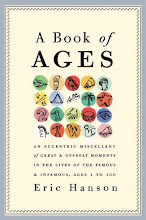(This essay first appeared in Leite's Culinaria in 2009, where it has been reprised this year.)
Early January has always been a time for rethinking and reinvention. New destinations get mapped out, new partnerships are sealed over lunch. Seed catalogs arrive while the garden is buried under snow. New projects are often dreamed up during the fallow week between Christmas and New Year’s. When nobody is doing business, everyone is planning.
New ventures seem like an especially good topic for this January, with its dramatic sea changes ushered in a year ago. January 2009 saw a new president, a new Congress, a harsh economic winter, and radically shifting circumstances. Our empty larder required all new ingredients. But there’s reason for hope in 2010: As a Chinese philosopher pointed out, crises also present opportunities.
Such opportunities can unfold swiftly, especially when we’re young. On a Christmas ski trip from Paris to Switzerland, Ernest Hemingway lost a suitcase containing all of his early stories; the ones he rewrote (often at tables in Paris cafés) are the ones that made him famous. A lost purse aboard a New York bus changed Carson McCullers’s career plans from concert pianist to author; she was 17. When he was 17, Aristotle Onassis was working as a dishwasher in a restaurant in Argentina. But not for long. James Beard failed at acting before he turned to cooking for a living. He was 32 when he opened a small catering business in New York in 1935.
Youth is open to new possibilities because everything is possible and nothing is certain. There is so much that has not yet been tried. Robert M. Parker was 20 and spending Christmas in France when he tasted his first glass of wine. Did it make a crucial difference that Alice Waters, when she was 19, transferred from the University of California in Santa Barbara to Berkeley? It was in Berkeley where she opened Chez Panisse in 1971, when she was 27. Often it’s a matter of being at the right place at the right time. When he was 19, film director David Lean had a job serving tea and pastries. The job just happened to be at London’s Gaumont film studio.
New beginnings can happen at any age. Julia McWilliams was well into her thirties before she learned to cook. In 1942 she was living in Washington D.C., in a two-room apartment in the Brighton Hotel, working for the Office of Strategic Services, the wartime forerunner of the CIA. What cooking she did was managed on a hotplate she kept atop the refrigerator in her living room; being 6′2” made this a bit easier. She met fellow spy Paul Child on the veranda of a tea plantation in Ceylon (a perfect place for spies to meet.) Paul introduced her to some of the better things in life, including proper, interesting food. They married, and in November 1948, Mr. and Mrs. Child arrived in France. Her first visit. Somewhere on the road between Le Havre and Paris she had her first French meal: oysters, sole meunière, salad, cheese, and coffee. France changed her life. Her experience of France changed ours.
Necessity and boredom often provide the spur that launches us in new directions. Martha Stewart quit the modeling business when she became a mother at 24. Home and kitchen were a new field, with a new skill-set, a new area of competence. But it would be another eleven years before she became a food maven at 35. Irma Rombauer was 52, a widow, with grown children, when she took a sheaf of old mimeographed recipes to an inn in Charlevoix, Michigan, and began writing a cookbook. In 1930 there were millions of American women who suddenly needed to cook for themselves, by themselves. (One of Rombauer’s helpful instructions: “Stand facing the stove.”) The Joy of Cooking made Rombauer a household name. Alice B. Toklas published her famous cookbook in 1954, when she was 77. She too had been collecting its recipes all her life. Anna Mary Robinson Moses spent many years raising children, putting up preserves and selling homemade butter and potato chips before she took up painting and became famous at age 78. Her first paintings were shown at the county fair in upstate New York; her raspberry jam won a ribbon, but her art did not.
Food is a key ingredient in many creative endeavors. Proust begins A la recherche de temps perdu with a bite of a madeleine, which unleashes the subsequent thousands of pages. Dickens’s first novel also begins around a table. Truman Capote’s most famous story is about breakfast in a place that doesn’t serve breakfast; his best-loved story is about fruitcake. It is significant that Hemingway titled his last book, A Moveable Feast. One of the most important stories in the Bible involves a bite from an apple. Cezanne’s most sublime paintings are of apples and pears, but apples and pears like no apples and pears we’ve ever eaten, as if the artist needed to reinvent the fruit before setting brush to canvas. You could say that cooking was humankind’s first invention, our first improvement on nature, taking raw ingredients and circumstances and making the best we could of them, something enjoyable and worth living for.
Perhaps it’s a good idea to begin the New Year in the kitchen, trying something new. Experimenting, discussing, tasting, attempting, sharing. It will be interesting to see what happens next.
(These stories and many others appear in A Book of Ages, which is an appetizing read for any year.)
Wednesday, January 6, 2010
A New Year for the Ages
Labels:
Alice B. Toklas,
Alice Waters,
food,
friends,
Hemingway,
Irma Rombauer,
James Beard,
Julia Child,
New Year's,
Proust
Subscribe to:
Post Comments (Atom)





No comments:
Post a Comment